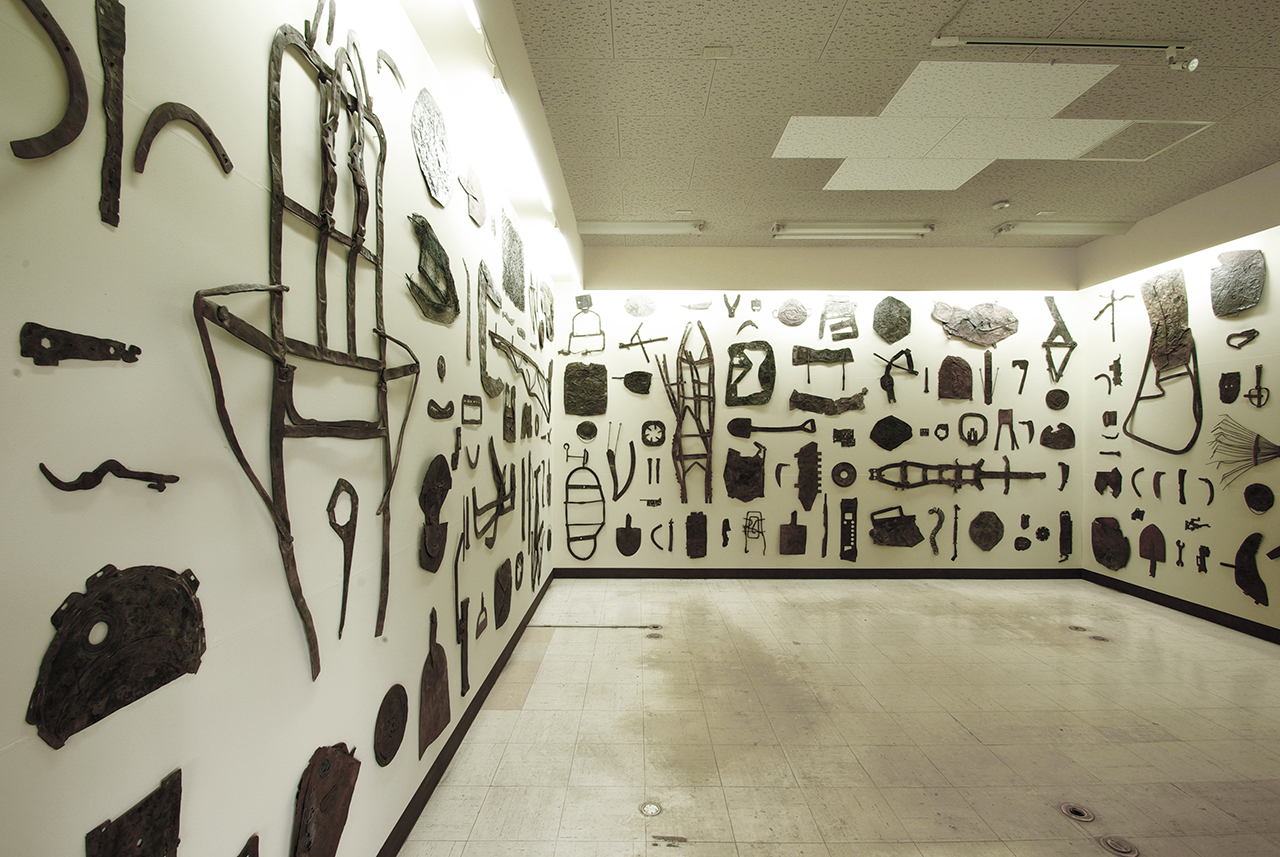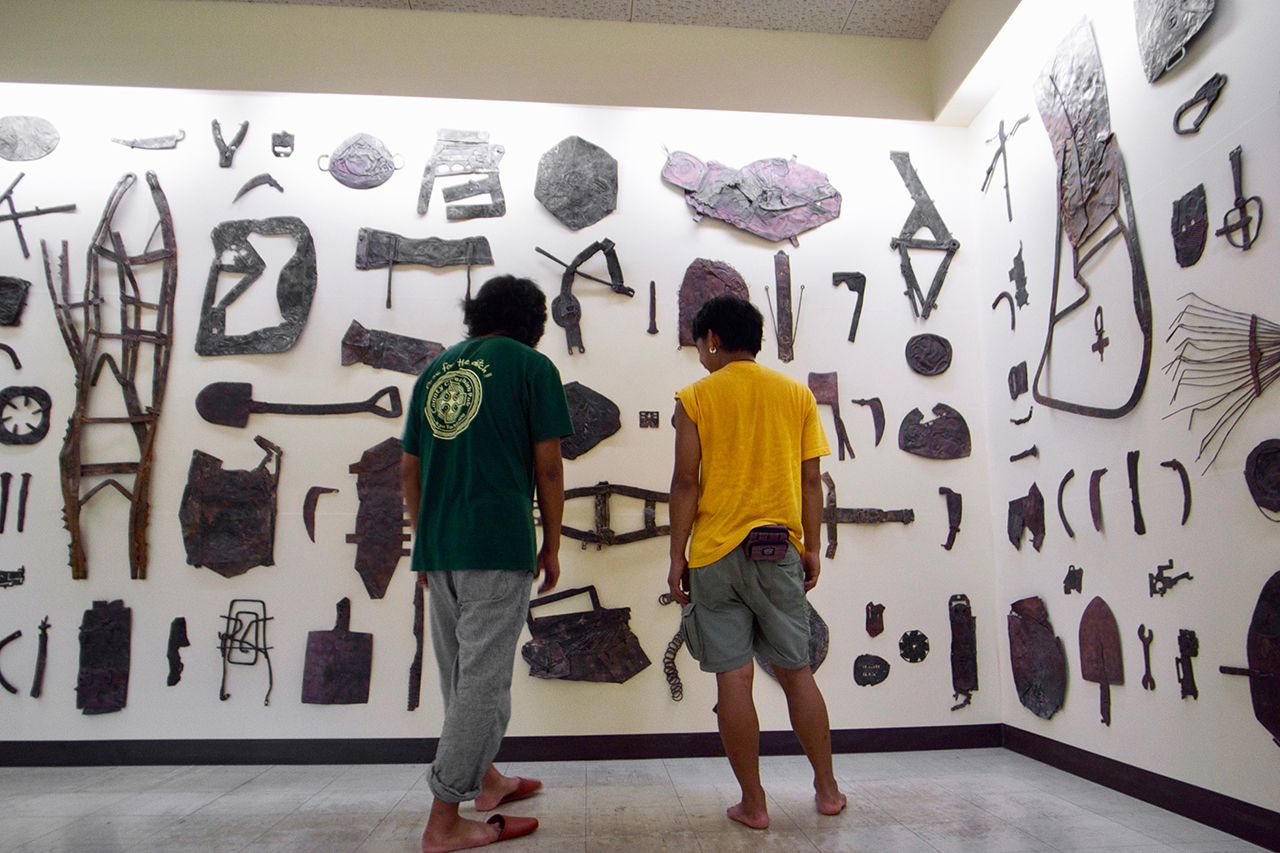
鉄という素材は、それの持つ堅牢さと優れた加工性から、さまざまなシーンで活用されている。時に建築や乗り物の骨格として、時に生活へ利便性を与えるものとして、時に武力として。その活用範囲の広さは、鉄が「道具」として文化へ大きな影響をもたらしてきた裏付けとも言える。
では、「道具」とは?
身の回りを見渡すと、現代では高性能なモノ、コストパフォーマンスに長けたモノ、エコロジカルなモノなど、その特長は多種多様であるが、もとをたどれば石を割ってナイフを作り、土を盛って水を蓄えたところに道具の原点を見る事が出来る。つまり、道具とは「素材に機能や構造を与えて成り立つ」と言えるだろう。それならば、道具から機能を取り去った時、そこには何が残るのだろうか?思考のなかで、ひとつの仮定が導き出される。
素材+機能=道具 ならば、 道具-機能=素材??
モノづくりのプロセスを逆行していく試みである。
この「引き算」は成立するのだろうか?
検証として、さまざまなスチール製品を赤熱し、ひたすら叩き続ける。1000℃を越える高温のなかでメッキや塗装は剥がれていく。何千、何万と金槌が振り下ろされ、機能や構造は失われていく。
人の手で作られた鉄製品から人為的な要素が取り除かれた時、素材は裸身を露にし始めた。それは無機質で無言な物質でありながら、躍動的で生々しいまでの純粋さを見ることが出来た。
ここ越後妻有の地にも、古くは鍛冶仕事で作られた農機具をはじめ、現代では乗り物や外装、内装等、さまざまな場所に鉄が用いられてきた。道具たちは、この地の水と土をふんだんに含み、厚く錆を身にまとう。その様はすでに人の手を離れ、大地を在るべき場所とし、そこへ還元されようとする素材の姿ではないだろうか。しかしこれらは単なる鉱石に戻る事はできない。制作者や使用者の手を経てモノは何らかの痕跡を残し、人は記憶を宿すからである。時間と出来事は逆行し得ないのだ。私はこれをを受容し、鎚をかさねて圧縮していく行為を経て、人々の生活や営みを照らし出す場を形成していく。願わくば、この旧東下組小学校に残されたさまざまな痕跡と響きあう場でありたい。
Steel making

The material named “Iron” has been used in variable purposes and stages because of its strength, durability, and productivity. Sometimes it has been used as the basic frame work of architecture or vehicle. Sometimes it gives us convenience of life as instrument. Sometimes it gives us protection of life as armament. The wide range of the usage as “instruments” proves “how big the influence is in the civilization of human being”.
If so, what is “instruments”?
At present, in this sophisticated society, we can see a lot of instruments which have high quality, high performance per cost, high ecological consciousness. The configuration is varied so much. However, if we try to trace back to the origin of each modern instruments, we can return to primitive instruments, such as knives which were fabricated by breaking stones, or such as dish which were fabricated by keeping water in pieces of clay. In other words, “instruments” are the result of the process of “adding some functions or adding some constructions” on the raw material.If so, what are the “remaining”, when we remove the functions or constructions from the “instruments”? Here is one hypothesis as follows, after consideration.
Material + Function = Instrument If so, Instrument – Function = Material??
This is a trial to reverse the process of the fabrication of instruments from down stream to upper stream. I am asking myself, “Surely is this reverse process possible? Namely “Is subtract process possible?”
In order to prove this, I am heating up the steel instruments and hammering them again and again. In this “subtract process” at the temperature of over 1000 degree C condition, the plating and painting on the instruments are lost. In the process of thousands and millions of hammering, the function and construction are lost. After all the artificial elements are removed from iron products, which were made by human, gradually the iron materials start shining from their naked bodies. They are inorganic materials and silent materials. However I can feel some kind of purity which is living and shining in their naked bodies.
Here, in Echigo Tsumari, in ancient times, people used iron instruments made by forging for agriculture. Now, in modern times, people use iron instruments treated by sophisticated process for transportation gears and for exterior / interior of architectures. Anyway sooner or later, the instruments start to wear thick rust which contains water and soil in this land. This formation seems a process of reverse of the manufacturing. The instruments are coming out from human hands and they are returning to the land, which is the birthplace of the material.
However they can not return to the original mineral stones, because they have already worn traces of activities of manufacturers and users. Meanwhile people have memories of usages of the instruments. In other words, times are passing through the instruments and events are passing through the instruments. They can not wind back. History can not reverse. I accept this reality. I continue hammering and compressing the instruments. I would like to give new stages for the instruments, where they can light up the people life and people activities. And I hope the stages will harmonize with various traces of memories of Higashishimokumi elementary school.



























